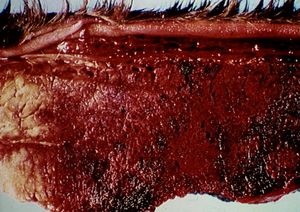Difference between revisions of "Black Leg"
| Line 18: | Line 18: | ||
In cattle it is typically beef breeds who are affected particularly animals in good health and good body condition. More frequently occurs in cattle between 6-24 months old but can affect animals of any age. In some animals lesions occur following muscle trauma, which is thought to activate latent spores in the muscle. | In cattle it is typically beef breeds who are affected particularly animals in good health and good body condition. More frequently occurs in cattle between 6-24 months old but can affect animals of any age. In some animals lesions occur following muscle trauma, which is thought to activate latent spores in the muscle. | ||
In sheep, cases typically occur following some form of injury such as shearing cuts, docking or castration. | In sheep, cases typically occur following some form of injury such as shearing cuts, docking or castration. | ||
| + | Tends to affect animals in the summer months. | ||
==Diagnosis== | ==Diagnosis== | ||
| Line 24: | Line 25: | ||
==History and Clinical Signs== | ==History and Clinical Signs== | ||
| − | Spores | + | Spores pass through the wall of the GI tract and via the bloodstream enter the muscle where they then lie latent. Under the correct conditions (usually anaerobic following injury) they germinate and bacilli grow. Toxins damage the capillaries causing a serosanguinous exudate. Muscle necrosis occurs due to gas producing bacteria resulting in emphysaema and crepitus |
| − | The bacteria can cause rapid toxaemia resulting in death, however if clinical signs do occur these can include toxaemia, pyrexia, depression, [[Lungs Circulatory - Pathology#Pulmonary oedema|pulmonary oedema]], circulatory collapse | + | The bacteria can cause rapid toxaemia resulting in death, however if clinical signs do occur these can include toxaemia, pyrexia, depression, [[Lungs Circulatory - Pathology#Pulmonary oedema|pulmonary oedema]], circulatory collapse lameness and swollen hot muscles which later become cool as necrosis occurs. |
| − | lameness and swollen hot muscles later | + | |
| − | + | ==Pathology== | |
| − | + | ||
| − | + | In the early stages the musce periphery appears dark red and is Distended by serous or serosanguinous exudate. Is wet on the cut surface | |
| − | + | and the centre of the lesion is full of gas bubbles, porous, dry, reddish black | |
| − | |||
| − | |||
| − | |||
| − | |||
| − | |||
| − | |||
***Rancid odour | ***Rancid odour | ||
*Histologically: | *Histologically: | ||
| − | + | In the early stages separation of the myofibres by exudate can be seen which progresses to [[Necrosis - Pathology#Coagulation Necrosis|Coagulative necrosis]] No nuclei | |
| − | |||
| − | |||
| − | |||
**Old stage | **Old stage | ||
***Fragmented muscle fibres separated by gas bubbles | ***Fragmented muscle fibres separated by gas bubbles | ||
***Gram positive bacilli may be found in clumps | ***Gram positive bacilli may be found in clumps | ||
[[Category:Sheep]][[Category:To_Do_-_Caz]] | [[Category:Sheep]][[Category:To_Do_-_Caz]] | ||
| + | |||
| + | ==Treatment== | ||
| + | ==Prognosis== | ||
| + | ==References== | ||
Revision as of 22:17, 18 July 2010
| Also known as: | Blackquarter
|
Description
A bacterial disease affecting cattle and sheep caused by Clostridium chauvoei. Latent spores of this organism are deposited in the muscle and liver of ruminants via the circulation resulting in oedematous and crepitant swelling of the muscles.
Signalment
In cattle it is typically beef breeds who are affected particularly animals in good health and good body condition. More frequently occurs in cattle between 6-24 months old but can affect animals of any age. In some animals lesions occur following muscle trauma, which is thought to activate latent spores in the muscle. In sheep, cases typically occur following some form of injury such as shearing cuts, docking or castration. Tends to affect animals in the summer months.
Diagnosis
Diagnosis is made on clinical signs and muscle biopsy. Affected muscle is black, dry and infiltrated with small bubbles. The lesions can be present in any muscle. Often in sheep, lesions are deep and quite small. Suspected cases can be confirmed using demonstration of C. chauvoei in affected muscle using the fluorescent antibody test.
History and Clinical Signs
Spores pass through the wall of the GI tract and via the bloodstream enter the muscle where they then lie latent. Under the correct conditions (usually anaerobic following injury) they germinate and bacilli grow. Toxins damage the capillaries causing a serosanguinous exudate. Muscle necrosis occurs due to gas producing bacteria resulting in emphysaema and crepitus The bacteria can cause rapid toxaemia resulting in death, however if clinical signs do occur these can include toxaemia, pyrexia, depression, pulmonary oedema, circulatory collapse lameness and swollen hot muscles which later become cool as necrosis occurs.
Pathology
In the early stages the musce periphery appears dark red and is Distended by serous or serosanguinous exudate. Is wet on the cut surface and the centre of the lesion is full of gas bubbles, porous, dry, reddish black
- Rancid odour
- Histologically:
In the early stages separation of the myofibres by exudate can be seen which progresses to Coagulative necrosis No nuclei
- Old stage
- Fragmented muscle fibres separated by gas bubbles
- Gram positive bacilli may be found in clumps
- Old stage
